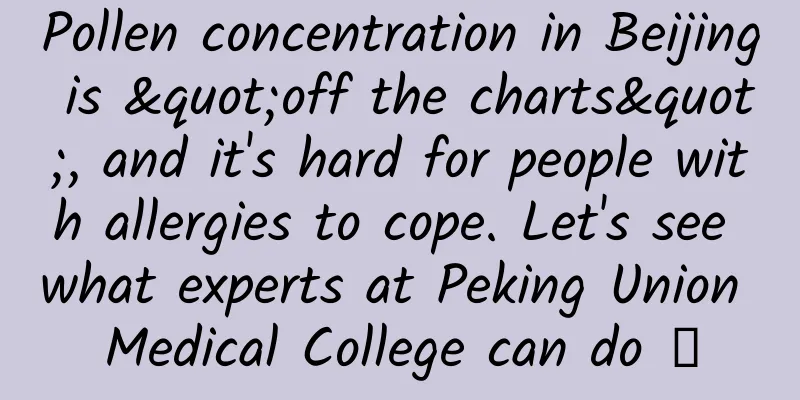Pollen concentration in Beijing is "off the charts", and it's hard for people with allergies to cope. Let's see what experts at Peking Union Medical College can do →

|
Reporter/Li Jing Editor/Ji Jingjing Interview experts: Yin Zhaoyin (Senior Engineer, Beijing Meteorological Service Center) Gu Jianqing (Deputy Chief Physician, Department of Allergy, Peking Union Medical College Hospital) A-choo, A-choo, A-choo … Several sneezes in a row Could it be a cold? Don't rush to conclusions!!! Beijing has recently entered the pollen season. Continuous sneezing, It is also accompanied by itchy nose, itchy eyes, and rash. Even asthma. Don't just think about the cold. This is more likely an allergy to pollen! Total pollen concentration in Beijing by month (Picture from the Beijing Meteorological Service Center's "Pollen Monitoring and Forecasting" official account) Pollen season is here again, and concentrations will remain high for the next week In early March, pollen began to appear in Beijing's urban area, and its concentration began to rise rapidly from March 13. Yin Zhaoyin, senior engineer of Beijing Meteorological Service Center, said that according to monitoring data, the daily precipitation exceeded 2,000 grains/1,000 square millimeters from March 14 to 17. The precipitation decreased on March 20 due to overcast and light rainfall, but still remained above 400 grains/1,000 square millimeters. Data from the Beijing Meteorological Service Center's "Pollen Monitoring and Forecast" WeChat account showed that Beijing's pollen concentration was extremely high on March 23, reaching an average of 7,792 grains per 1,000 square millimeters. It is expected that the city's pollen concentration will remain high in the near future. Yin Zhaoyin said that over the past 10 years, the pollen concentration in Beijing has shown an overall increasing trend, and began to increase further in 2021. In fact, against the backdrop of global warming, pollen around the world has seen an increase in total amount, an earlier pollen season and a longer duration. "The pollen season this year is similar to previous years." Yin Zhaoyin predicts that Beijing's spring pollen season will last for another two months, with the main pollen from late March to late April being strongly allergenic Cupressaceae pollen, which will cause greater interference to people with allergies; after that, the main pollen will be Pinaceae pollen, which has a lower allergenic intensity and a weaker impact. TIPS: Pollen concentration is generally detected by gravity sedimentation, that is, the particles in the air naturally settle onto the sampler due to their own gravity. Then observe the pollen sedimentation results for 24 hours under a microscope and convert the number of pollen particles per 1000 square millimeters. The current pollen concentration forecast is divided into six levels, that is, less than 50 pollen particles per 1000 square millimeters is level one, 51-100 is level two, 101-300 is level three, 301-500 is level four, 501-800 is level five, and 801 or more is level six. Overview of Beijing's pollen situation (Photo from Beijing Meteorological Service Center's "Pollen Monitoring and Forecasting" public account) Spring trees and autumn grasses are the main culprits of allergies, and Cupressaceae pollen is causing trouble Yin Zhaoyin pointed out that the allergenic pollen mainly comes from trees and weeds such as Cupressaceae, Salicaceae, Asteraceae, Moraceae, and Arboraceae, rather than common spring ornamental flowers such as cherry, peach, apricot, and plum. In fact, this is related to the pollination method of plants. Ornamental flowers generally use insects as media to spread pollen, which is not easy to cause allergic reactions. On the contrary, after blooming, unattractive trees and grasses often use wind as a medium to spread a large amount of pollen in the air. These pollen particles enter the respiratory tract or come into contact with the mucous membranes and skin, causing allergic reactions. It can be seen that "wind-pollinated flowers" are the "big enemy" of people with pollen allergies. Woody plants can produce a lot of pollen (picture from the Internet) "Beijing's pollen season has two peaks, one in spring and one in autumn," Yin Zhaoyin said. In spring, woody plant pollen is dominant, while in late summer and early autumn, herbaceous plant pollen is dominant. The male cones on the male juniper plants release a large amount of pollen (picture from the Internet) At present, pollen in Beijing mainly comes from poplar, willow, cypress and elm. In terms of allergenicity, the pollen that is "making waves" in spring is the Cupressaceae pollen, which only needs a very small amount of pollen to cause symptoms in a large number of allergic people; and the pollen of the Salicaceae family is highly allergenic due to its large output. In late summer and early autumn, pollen from the genus Artemisia in the Asteraceae family is the most popular, followed by pollen from the genus Humulus in the Moraceae family, which has a very high yield and is highly allergenic. Although pollen from the genus Poaceae and Chenopodiaceae are also the main pollen in late summer and early autumn, they are not highly allergenic. Pollen types that are easy to detect (Picture from the Beijing Meteorological Service Center's "Pollen Monitoring and Forecasting" public account) How to distinguish continuous sneezing from a cold? "The number of people allergic to pollen in my country has increased year by year," said Gu Jianqing, deputy chief physician of the Department of Allergy at Peking Union Medical College Hospital. Pollen allergy is an allergic reaction disease. It may seem like a minor disease, but its impact on the human body will gradually increase, and it can affect the nasal mucosa, conjunctiva, bronchi and skin. It cannot be completely cured and is prone to recurrence. In the early stages of pollen allergy, symptoms such as sneezing and runny nose can be easily confused with colds. However, pollen allergy is a gradual process, and timely identification and determination of allergens can better control symptoms. In fact, pollen allergy is quite different from colds. For example, during the onset of allergic rhinitis, there are often several paroxysmal sneezing episodes, which may occur several or even dozens of times in a row; sometimes the nose becomes itchy, with a lot of clear nasal discharge and nasal congestion; there are also itchy eyes caused by allergic conjunctivitis. Therefore, for people with no history of allergies, if they experience nasal itching, several bouts of runny nose, clear runny nose, nasal congestion, etc., and have no fever or general weakness, it is recommended that they seek medical attention in a timely manner if conditions permit, identify the allergens, and do not take medicine directly as if they have a cold. Do allergen testing (picture from the Internet) Fighting pollen allergies: physical protection takes the lead "Physical protection" is very important for people who are allergic to pollen, as it can block allergens and reduce the risk of allergies. Therefore, before the pollen season arrives, people who are allergic to pollen should remind themselves that it is time to "be fully armed" again. Gu Jianqing reminded that people with pollen allergies should wear masks and goggles when going out, and those with skin allergies should wear long-sleeved clothes. After returning indoors, they need to wash their hands and face as soon as possible and change clothes to avoid bringing pollen carried by clothes into the room and causing allergies. After pollen allergy occurs, antihistamines (the so-called "anti-allergic drugs") or topical glucocorticoids are often used for treatment. If asthma has occurred, long-term use of inhaled glucocorticoids is required. In severe attacks, intravenous or oral hormones are also required. On the basis of symptomatic treatment, Gu Jianqing also mentioned the "desensitization treatment" program. For severe patients, allergen-specific immunotherapy can be considered. Generally, patients are over 5 years old and start treatment after the pollen season ends and the condition stabilizes. The course of treatment is relatively long, generally requiring three years or even longer. The level of pollen deposition is low, so it is also recommended to take protective measures (Picture from the Internet) Yin Zhaoyin also pointed out that the time period with the highest pollen concentration is from 10 am to 4 pm, and people who are allergic to pollen can choose to avoid outdoor activities during this period. In addition, the current level of pollen detection data cannot be simply matched to the degree of allergic symptoms, especially the inability to distinguish the types of allergenic pollen. Therefore, even if the pollen deposition level is low, it is recommended to take protective measures. |
<<: Health Science | How to lose weight scientifically?
>>: World Sleep Day | Healthy sleep for everyone
Recommend
What's the matter with the glucose 3 plus in the urine test for pregnant women?
After a woman becomes pregnant, she needs to go t...
Why do women get infected with bacteria?
Almost all women will have some inflammation. Reg...
What foot bath is better for pregnant women?
Normally, we use the method of foot soaking, whic...
Children also have diabetes
Diabetes is a serious chronic disease, and its in...
Why does eating pumpkin increase blood sugar instead of lowering it?
It's pumpkin season again. Pumpkins are soft,...
How to prevent pregnancy after cesarean section?
Caesarean section has certain risks for many moth...
How to store lychees if you have too many to eat? Why do lychees have bugs?
Fresh lychees are all with leaves and branches, a...
Breast pain a few days before period
Some women will experience breast pain a few days...
Is it normal to have pelvic floor at 34 weeks of pregnancy?
Pregnancy is a very important stage for women. Th...
Girls urinate blood
Generally speaking, you can inquire about a perso...
Camia: Top 100 Apps & Games Downloads in Q1 in Indonesia
This issue of CAMIA collected the data of the top...
How to enlarge breasts for a 40-year-old woman
How can a woman in her forties have a big breast?...
How long does it take to have a baby after the IUD is removed?
There are many contraceptive methods that modern ...
How many days after menstruation is the dangerous period?
For young couples, the dangerous period refers to...
What is the reason for stomach pain when you are more than 7 months pregnant?
What causes abdominal pain in the seventh month o...









